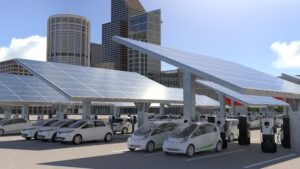Measuring and optimizing the environmental footprint of business IT systems is more important than ever due to the tremendous acceleration of digitization we’ve witnessed in recent years. At Schneider Electric, we’ve created a holistic Green IT program consisting of four pillars that aim to assess, control, and reduce the carbon footprint caused by digital technology.
In this fourth and final blog of this series, I’d like to emphasize the importance of combining cutting-edge IT solutions that make sustainability reporting easier than ever – with the engagement of employees and their awareness about the environmental cost of digital tools they use every day. I firmly believe that this combination is required to make IMPACT for a sustainable future of the IT industry.
Innovation and employee engagement: driving corporate sustainability initiatives
For several years, our IT teams have been using EcoStruxure IT DCIM to monitor our energy usage and emissions. They have also recently integrated our EcoStruxure IT Expert solutions to further analyze and assess our progress in reducing emissions in our IT environments. We are proud that through years of investment, development, and testing by our own IT team, we are now rolling out new, sustainability focused features in EcoStruxure IT.
At the same time, we realize that it takes more than just technology to ensure that our technological advancements are environmentally conscious. The other success factors are people and their engagement.
For a few years now, the employee engagement around IT sustainability gradually started gaining positive momentum thanks to our communication initiatives that emphasized that sustainability and digital go hand-in-hand. By building awareness, providing practical knowledge, and encouraging active participation, we have successfully engaged our employees in our sustainability journey. Today, 350 volunteers across the world are ambassadors of our Green IT program with the objective of spreading the word among all our employees, but also by doing research and bringing up new ideas to feed our Green IT strategy.

Simple actions make an IMPACT
Not many of us know that sending an email with a 1MB attachment to one recipient consumes 25 watt-hours, the same as having a light bulb running for two hours. Or that only 14% of data is considered business critical, while the remaining one is categorized as “dark data,” the storage of which contributes to CO2 emissions. These are just a couple of examples of the digital cost of everyday actions we all make and some of the messages delivered.
Our Green IT program is not only about EcoStruxure IT solutions and corporate initiatives, but also about the personal IT changes we all can make to contribute to reducing the GHG emissions of our company, and ours.
At Schneider Electric, we recognize the immense influence our 150K+ employees worldwide have on our digital footprint. That’s why it is vital for us to foster a culture of sustainable-first actions, integrating our approach to digital technology. The message is clear: every digital interaction, from powering smart devices to sending emails and attending online meetings, comes with an environmental cost in the form of carbon emissions.
We’ve also been promoting green search engine practices. In 2023, our searches have financed 7.752 trees. This not only aids in reversing biodiversity loss, but also contributes to about 220kg of carbon sequestration per year through absorption*.
Green IT: an ongoing commitment and vision
Today, our dedication to promoting employee engagement and advancing sustainable IT practices remains unwavering. Green IT has become an integral part of our company culture, and we are actively working on new initiatives to enhance awareness and foster a greener future for all.
I hope this series of blogs about our Green IT strategy has provided you with valuable insights, inspiring you to consider embarking on a sustainable IT journey. As an IMPACT company, our Green IT practices align with our Environmental, Social, and Governance (ESG) values and our digital vision. If you want to know more about our corporate sustainability strategy and commitments, visit our webpage.
*Carbon sequestration is the process of capturing and storing atmospheric carbon dioxide. It is one method of reducing the amount of carbon dioxide in the atmosphere with the goal of reducing global climate change.




Add a comment